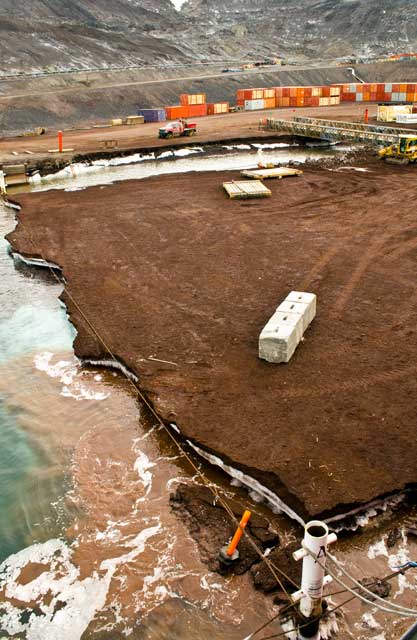|
Video Information
In the animation above, images from NASA's Aqua and Terra satellites are stitched together from mid-September 2013 to mid-February
2014 to show the dramatic break out of sea ice from McMurdo Sound. The lack of sea ice allowed winds and waves to break up the
McMurdo Station ice pier and icebergs to calve from the McMurdo Ice Shelf. There is no sound associated with this video. Video
courtesy of Paul Morin, Polar Geospatial Center.
Harsh continentStorms and waves batter McMurdo Station due to absence of sea icePosted February 21, 2014
Mother Nature has not been kind to McMurdo Station Melt pools at the airfield. A disintegrating ice pier. Small icebergs calving from the ice shelf. Deteriorating conditions on the transition road between Ross Island and the permanent ice shelf. Fortunately, it’s still too cold for locusts – but Antarctica has proven once again why it’s often referred as the world’s harshest continent. Above average warm and sunny weather in early January created severe melt issues at the Pegasus Airfield In the ensuing weeks, the sea ice in McMurdo Sound broke earlier and more extensively than normally experienced. By early February, extreme tides and then a storm that kicked up huge waves across McMurdo Sound pounded and flooded the ice pier. Chunks of the McMurdo Ice Shelf, also no longer protected by the sea ice that usually fills McMurdo Sound, started to break off around that time. That raised concerns for the 14 miles of fuel hose that stretches between McMurdo Station and Pegasus Airfield not far from the ice shelf edge. The storm that hit on the evening of Feb. 6 blew in with winds of 40 knots or more that kicked waves high and hard against Hut Point, a peninsula that juts out into McMurdo Sound where Robert Falcon Scott built his first expedition base in 1902. The sea spray swept across the hut itself. “This was not that big of a storm. It would have been amazing to see what would have happened if it had been a big storm,” said Steve Dunbar, McMurdo area manager for the U.S. Antarctic Program (USAP) A veteran of the USAP since 1991, who for many years was the leader of the Search and Rescue team, among other jobs, Dunbar noted that far worse storms have hit McMurdo in the past and much more severe weather is encountered in some of the coastal deep-field camps as well. The key difference this time around, he emphasized, was the lack of sea ice to dampen the wave action. 
Photo Credit: Peter Rejcek
The surface of the ice pier began to deteriorate before the February storm due to wave action unimpeded by sea ice.
The supply vessel Maersk Illinois was still tethered to the ice pier when the storm first rolled through. All of its cargo – from heavy machinery to frozen food – had been unloaded. However, not all of the northbound cargo, including science samples such as ice cores and meteorites, had been loaded on the ship. The storm pinned the Maersk Illinois to the pier until a window opened in the weather on Feb. 7, allowing the cargo vessel to ease its way out of Winter Quarters Bay. The winds continued on and off through Feb. 9 before they finally abated. By then, the pier had been battered and broken into six pieces. The pier – made with layers of ice and steel cables and topped with an insulating layer of dirt – had already been in trouble well before the storm hit. By late January, the top outer edge of the pier started eroding away due to wave action, possibly caused by what are called king tides, extreme tidal swings caused by the proximity of the moon to the Earth. Heavy equipment operators with the station’s Fleet Operations department attempted to slow the erosion by adding rocks and concrete blocks to the edge of the pier as a buffer. That worked well enough to allow the fuel tanker Maersk Peary to unload about 3.5 million gallons of fuel before the beginning of February. The resupply vessel, which carries most of the cargo required to operate McMurdo and South Pole stations for the year, then arrived. Dunbar said it appeared that the tides caused the pier to ground on one end, eventually causing it to break. “When the pier settles down on one corner it puts a lot of stress on it, and it cracks,” he explained. Maggie Knuth, the Operations manager for the National Science Foundation’s Division of Polar Programs “However, combined with the strong storm, it was just too much for the pier this season,” she said. |



For USAP Participants |
For The Public |
For Researchers and EducatorsContact UsNational Science FoundationOffice of Polar Programs Geosciences Directorate 2415 Eisenhower Avenue, Suite W7100 Alexandria, VA 22314 Sign up for the NSF Office of Polar Programs newsletter and events. Feedback Form |

